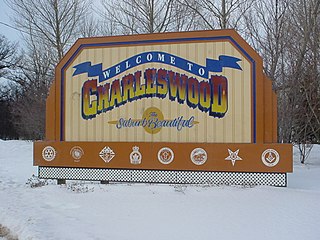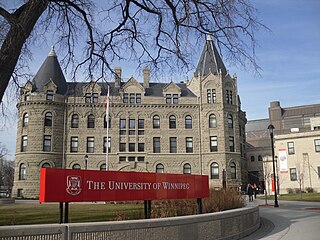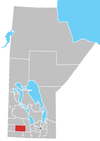Neelin is a small community in the Canadian province of Manitoba. It is located on Manitoba Provincial Highway 5 in the Rural Municipality of Argyle, about 29 km east of Killarney, or about 200 km southwest of Winnipeg.

St. John's College is an Anglican-based independent constituent college of the University of Manitoba, located on the university's Fort Garry campus in Winnipeg, Manitoba.

Charleswood is a residential community and neighbourhood in Winnipeg, Manitoba, Canada. It is located in the South-West of the city and is bordered by the neighbourhoods Tuxedo to the East, Fort Whyte to the South, and the Rural Municipality of Headingley on the West. It's boundaries are Roblin and the Assiniboine River to the north, Shaftesbury Boulevard on the East, Wilkes Avenue to the South and the Perimeter Highway to the West.

Winnipegosis is an unincorporated urban community in the Rural Municipality of Mossey River, Manitoba, Canada. It lies at the mouth of the Mossey River on Lake Winnipegosis in west-central Manitoba.

Killarney is an unincorporated community in southwestern Manitoba, Canada, at the corner of Manitoba Provincial Trunk Highways 3 and 18.
Ashern is a local urban district located in the Municipality of West Interlake in Manitoba's Interlake Region.
Lundar is a local urban district in the Rural Municipality of Coldwell, Manitoba, Canada. Located in Manitoba's Interlake Region, it is situated 99 km (62 mi) north of Winnipeg on Highway 6.

Wesley College was a college that existed in Winnipeg, Manitoba, Canada, from 1888 to 1938. In 1924, Wesley College became part of the United Church of Canada. It was one of the University of Winnipeg's founding colleges.

St. Clements is a rural municipality (RM) in Manitoba, Canada. It is located to the north-east of Winnipeg, stretching from East St. Paul and Birds Hill Provincial Park in the south to Lake Winnipeg and Grand Beach Provincial Park to the north. The Red River demarcates the western boundary of the municipality. St. Clements contains the communities of East Selkirk, and Lockport east of the Red River. It almost completely surrounds the Brokenhead 4 Indian reserve, with the exception of a small lakefront on Lake Winnipeg.

Riverton is an unincorporated urban community in the Municipality of Bifrost-Riverton within the Canadian province of Manitoba.

Warren is an unincorporated community recognized as a local urban district 26.3 kilometres north-west of Winnipeg, Manitoba. It is located in the Rural Municipality of Woodlands.
Bernice is an unincorporated place in the Municipality of Two Borders, 115 kilometres (71 mi) south-west of Brandon, Manitoba, Canada.
Woodlands is an unincorporated community in the Rural Municipality of Woodlands in the Interlake Region of Manitoba, Canada. It is located approximately 40 kilometres north-west of Winnipeg.
St. François Xavier is an unincorporated urban centre located in the Rural Municipality of St. François Xavier, Manitoba, Canada. It is located about 15 km west of the city of Winnipeg on the Assiniboine River.

The Municipality of Bifrost-Riverton is a rural municipality (RM) in the Canadian province of Manitoba, and is one of the northernmost rural municipalities in the Interlake Region.
Sarto is an unincorporated community in Manitoba, Canada, within the Rural Municipality of Hanover. The community is centred on PR 205, 7.5 kilometres west of Grunthal and 16 kilometres south-west of Steinbach.
Gordon is an unincorporated community in Manitoba, Canada, within the Rural Municipality of Rosser. The community is centred on PTH 6, approximately 3.5 kilometres north-west of Winnipeg and 9.5 kilometres south-east of Grosse Isle. It is named for James Gordon, who was in charge of leases in the General Manager's Office of the Canadian National Railway.
Roseland, Manitoba is an historical district located in the Canadian province of Manitoba. It is located just west of Manitoba Provincial Highway 10, in the Rural Municipalities of Whitehead and Cornwallis.










